How many eating utensils do people go through in a lifetime?
It’s not a question many people can answer, much less think to ask. The Japanese tradition of family members each owning designated pairs of ohashi (chopsticks), links different years of my life with various pairs I’ve used. It was only when I took its ubiquitous presence out of this quotidian context, that I came to appreciate the true ingenuity of ohashi.
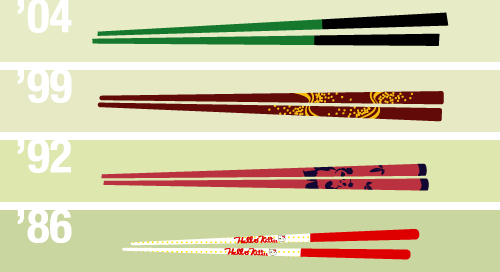
The history of chopsticks goes back to China 5000 years ago, where people started using twigs and branches to serve food. By 500 A.D., its use had spread to other Asian countries. In Japan, its initial form was that of tweezer-like pincers made of bamboo, which later became two separate pieces. Over the years, its design has developed into an art form. The colors, textures, shapes, and materials used are of a limitless variety. There are lacquered wooden pairs embedded with mother-of-pearl cranes. Some are made of bamboo, come painted with polka-dots and stripes, and are sold in little transparent bags at 100-yen stores for the equivalent of $1.20. Others are adorned with the smiles and logos of beloved anime characters and Sanrio creatures. Sold with matching plastic cases, they accompany children’s lunch boxes to school. There are even tiny instructional chopsticks with hooks and grooves attached, specially designed for correct grip and finger placement so youngsters can acquire their much-needed ohashi-using skills at an early age. (Unfortunately, I was never spoiled with a pair of these, so I can’t vouch for their efficacy.)
Until western eating habits started infiltrating Japanese homes around the end of WWII, the Japanese diet mostly consisted of fish, rice, and boiled or pickled vegetables. This and the fact that soups were directly sipped out of a bowl meant that chopsticks were really all a person ever needed to consume a meal — form beautifully followed all necessary functions. On the other hand, it’s interesting to see how the form affects the function as well. There is something precise and remarkably elegant about picking up grains of rice and morsels of fish with tapered ends of ohashi (once you get the hang of it). For me, the act implements a calmer rhythm when eating my meals – good for digestion since you avoid scarfing your food down.
Such utility never comes without a certain amount of do’s and don’ts. Here are a few I grew up with:
Don’t stick your ohashi in your rice: It’s reminiscent of offerings for the dead – usually inappropriate for dining room tables.
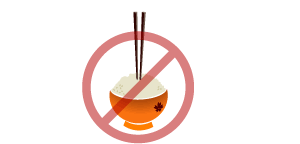
Don’t shishkabob your food: It’s unsightly. If you have to split something, work from the outside in, not the other way around.
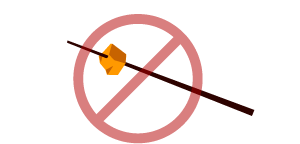
Don’t pass food from one pair of ohashi to another: Not just because of the potential mess you’ll make but because it’s reminiscent of Japanese funereal customs involving bones.
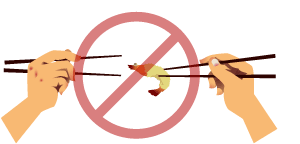
Do set pairs of ohashi at the front, next to the table’s edge, with the pointed ends towards the left: If you have ohashi-oki’s (chopstick holders), place them under the tapered ends.
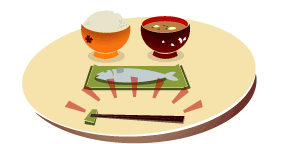
Do turn your ohashi around when using them to pick up food from a shared dish (family-style eating): It’s polite. Your saliva doesn’t get all over the food other people will be eating. From experience, I know this simple gesture can earn you major points at the table.
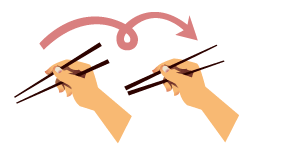
Not quite as complicated as western table manners, if you ask me… Now, which fork is the salad fork?
29 replies on “Chopsticks (Ohashi) Etiquette”
I think some of the Japanese (espesially younger generations)
often ignore the etiquette of No.2 and 5.
It’s really disappointing.
Thank you, this helps me alot.
What about left-handed people eating with their left hand?
regards
My understanding is that left-handed eating used to be quite impolite but that has diminished in recent times. It probably depends on the formality of the situation. Myself, I”m ambidexterous and eat equally poorly with either hand 🙂 So I’ll select the hand based on the crampedness of the situation (in a restaurant booth).
The big problem I run into is that I dislike the term “chopstick” because of its pidgin-english ancestry and prefer saying “ohashi” when requesting such. This often becomes an immediate clarifier as to whether the Japanese restaurant is staffed by Japanese or not 🙂
Wikipedia has a decent article on the utensils and their history:
http://en.wikipedia.org/wiki/Chopsticks
As to younger generation… my teenage son is half Japanese. He knows how to use them properly but will sometimes intentionally use bad etiquette just to see if he can “pull some chains” … o the joy of raising the heathen 🙂
Thanks a lot!
I’m from Sweden and but sometimes use ohashi since I find asian food/culture very interesting.
The pictures are very nice, but could you please explain No. 5 a bit more?
I dont really understand… when I try I just end up with the sticks crossing each other at 90 degrees….. 🙁
Maybe it’s no more than a matter of practise?
have a nice day
Thank you. I’m doing a research paper on ohashi for school, and I luckily came a cross this site from wikipedia. I had a little hard time finding a page with author, and easy to understand words. thank you.
I am Chinese, and have quite a few ohashi. I had those hello kitty chopsticks when I was younger. Now ( have a pair of ohashi that are black with blossoms painted on. They are pretty.
Thank you very much for this nice guide 🙂 It helped me a lot.
Very interesting. You might want to include “don’t point or guesture with you ohashi”, but that’s included in Wikipedia (the site I was redirected from to get here). Really wish I’d seen this page before I went to Japan for a semester. Unintentionally broke etiquette No.1 and my hostfamily got quiet. Nice info page.
^_^ Thanks for the guide! Now I know what to do and not do when I’m at a japanese restaraunt such as Kobe’s.
However, we’re usually seated with other Americans, so I don’t know that they’d notice and/or care.
Hello,
I like your pictures! So your website is very helpful and I was wondering what is to be done if someone is trying to pick something from a communal plate and is having difficulty. Should someone else assist? If so, how?
Also, what if someone finds that a piece of sushi is too large and cutting it would make a mess? Any suggestions for those who have quick throat reflexes and a large bite might be a problem?
Thanks and good luck!
Andres
I am a Japanese student.
It knew ‘chopsticks’ was introduced in the foreign country in this way and I
thought that I was glad. Life in Japan is very happy. If it can know the culture
and the history of Japan more, it is happy.
↑↑ Is my English correct in this?
Yamada,
Your english is difficult to read, and I am not sure what you are trying to say. Keep practicing!
Thought you might want to know that # 5 is wrong in Korea. Since it would mean that you would poke around the food with the not so sanitary part. Instead you should pick up the food without choosing and just with the tip of your chopsticks. 😉
i was wondering if anyone knew what hashi means? thats all!
Hashi literally means chopsticks in Japanese. It is written as 箸 in Japanese, Chinese (though there is another way to write it) and Korean [hanja].
where and how does one place chopsticks after meal…if you have also used fork,knife along with chopsticks?
What’s the proper way to eat rice with ohashi in Japan? Is it unseemly to bring the bowl to your mouth and sweep or “shovel” the rice?
as far as i know: in japan it is not unseemly to rais the bowl, actually most people raise the bowl and shovel the rice (from what i saw in japan)
How are noodles, like ramen, eaten with chopsticks? Udon is very difficult to eat with Western utensils, but not much easier with chopsticks.. “The Udon eel is very skilled at escaping back into it’s natural habitat.” 🙂
sweeping/shoveling rice is acceptable to my knowledge.
When you are done a meal place the chopsticks on the stand (ohashi-oki). If there isnt one place them horizontally pointing to the left ontop of the bowl. (I’m not certain on this but i’ve seen it enough times that it can’t be offensive).
As for the soup …. can’t help you there, carefully i suppose. Oh and for the other people who read this slurping your soup is more than acceptable in japan, it shows how much you like it.
sweeping/shoveling is normal in China, but it’s just NOT done in Japan. But it’s okay to lift the bowl almost to your mouth (lifting to about chest level is a bit more dignified). If you do use the shovel method in Japan, I don’t think it’s going to actually offend anyone; you’ll just look like a slob.
As some others have noticed, #5, while certainly recognized as polite, and I think it’s good sense, it’s just not very common; actually I’ve never seen a Japanese person perform it (although there might be some settings where it is practiced). Try it with a group of Japanese and you’ll probably be immediately made aware of how eccentric it’s considered.
I’m pretty sure skewing food (#2) is still considered pretty rude by most people.
sawing food (with a chopstick in each hand) is also considered rude, but is occasionally done when necessary.
#1 is the most important rule, although some people misunderstand it. It’s OK to leave your chopsticks in the rice bowl in the natural way (with the tapered ends in the rice, and the other ends supported by the rim of the bowl); it’s just not OK for them to be propped up in the rice vertically, as shown in the picture.
I always see #3 mentioned, so I assume it’s pretty rude, but I can’t imagine anyone doing it anyway…
As for noodles, well, I guess it takes some practice. The traditional method is just to grab into the bowl with your chopsticks, bring whatever you catch in the ends of the chopsticks to your mouth, and slurp up the hanging ends. If you’re not good at slurping, you can just bite and let the ends fall back into the bowl. The broth is usually drunk straight from the bowl (unless you’re given a spoon, in which case you use that).
i am asian and my family eats with chopsticks everyday; i can tell you that some of these practices are so archaic that if you bring them up you might get giggled at. furthermore, i don’t wish to call them ohashi because the term is strictly japanese and the utensils are not.
i think its more important to just learn to use the dang things with deftness and ease. knowing about funeral practices helps one avoid social awkwardness when dining with grandmothers or shintoists but beyond that, i think it’s most important to just enjoy your food and show the chef/host your appreciation. imho, making a point to be super correct in anything but the most formal, traditionalized eating situations (i.e. tea ceremony) will only make people consider you forced and pompous. be natural, have fun.
It’s worth pointing out that the japanese word for chopsticks is simply “hashi”. The “O” is an honorary prefix, appropriate in some situations and not in others. I’m not sure if you should use it in the context of an english sentence(“Can I please have some hashi?” vs. “Can I please have some o-hashi?”). Might want to check this out with a fluent Japanese speaker.
I would say that in english-speaking countries, it is probably best to just say “chop sticks”, as many japanese restaurants are run/staffed by chinese, korean, thai, or vietnamese people.
Sucking or licking any food debris off your chopsticks is supposed to be bad form, as much as licking the gravy off your plate!
These rules are not really that esoteric if you transpose them to western silverware. Would you leave your fork jabbed into your steak at a 90 degree angle? Stab a tomato with your knife and suck it into your mouth? Stick your spit-covered fork into the communal mashed potatoes? We have rules, too. They’ve just become so automatic that we don’t notice them. When you want the waiter to take your empty plate, you lay your utensils on the plate on a diagonal with the business ends to the upper left. Voila! “May I take that for you, sir?” Japanese table etiquette is actually simpler than western because they don’t have such a vast array of eating utensils. Now if I could just figure out how to use the bandage scissors that they give you at Korean barbecue restaurants….
I picked out a pair of reusable ohashi at an anime convention (animeNEXT) so I could practice for when I go to japan on july 13th because i don’t want to look like a dumb american. Thanks for the guide!
Hehee Thanks for the cool tips !
I love the accompanying illustrations, they’re really cute! If I ever make a “How to Use O-hashi” illustrated tutorial, I hope I can get/make illustrations as cute as yours!
I am Chinese and usually take no notice of chopstick etiquette. Most modern Chinese families attach no importance to them. My English teacher wanted us to find materials about Chinese culture. This post helped both my speech and life.